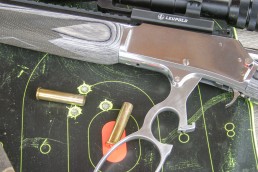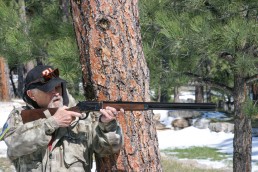Two Brand-New Hunting Rifles in 45-70 Government (Part 1)
SHARE THIS POST
As now offered by Ruger Firearms, being the new entry into the Ruger company, the new Marlin 1885 is a major step forward in lever-action rifle construction and performance. Reviewed here is a match in terms of quality and performance between the also very new introduction regarding the Uberti 1885 in 45-70 Government.
While I know it dates me, the first rifle I ever shot on deer was a Winchester Model 1873 chambered in 44-40 WCF. The rifle was my grandfather’s, and he lived off the land with it in the northern Minnesota back country, just after WWI. This was also the first rifle that I used to try to take deer. I have indicated that I “tried,” because the rifle was almost taller than I was from the ground up, and way beyond my proper fit.
The next level in lever-action rifles turned out to be a nice, lighter-weight and easy-handling Winchester Model 94 in 25-35 Winchester. The point being, I have grown up and lived a long life of shooting lever-action rifles, and to my way of thinking, the lever gun is a real American tradition to the core in terms of shooting sports.
With an amazing by-chance event taking place, being two different 45-70’s arrived at my shop on almost the same date, the thought occurred to me to compare one rifle to the other. Riflemen searching for a new entry into the big bore 45-70 department who don’t want a single shot Sharps— being most offered today (I own several and love them to death)—can now have the option of two new lever action rifles.
In the later years of my long association with these action types of rifles, I have the honor of addressing these two new and very well-dressed rifles in the Ruger-built Marlin 1885 chambered in the heavy hitting 45-70 Government cartridge, and the second option being the Uberti Winchester Model 1886 45-70 Government. In terms of rifle number one, the Marlin firearms has always been a leader in holding up the lever rifle as a modern go-to field piece. Because this Marlin rifle as built by the original company, but now owned and operated by Ruger firearms, has released the Model 1895 big bore rifle, it made major news largely because Remington, the previous owner of the brand, had not made much in the way of changes to the rifle as offered by the original Marlin firearms company. Ruger, being known for innovation, flexible adaptation of modern manufacturing and construction methods, offers state-of-the-art products to sport shooters regarding some very high-grade firearms at very reasonable prices. Now, Ruger has elected to put this rifle into shooters’ hands—a good decision.
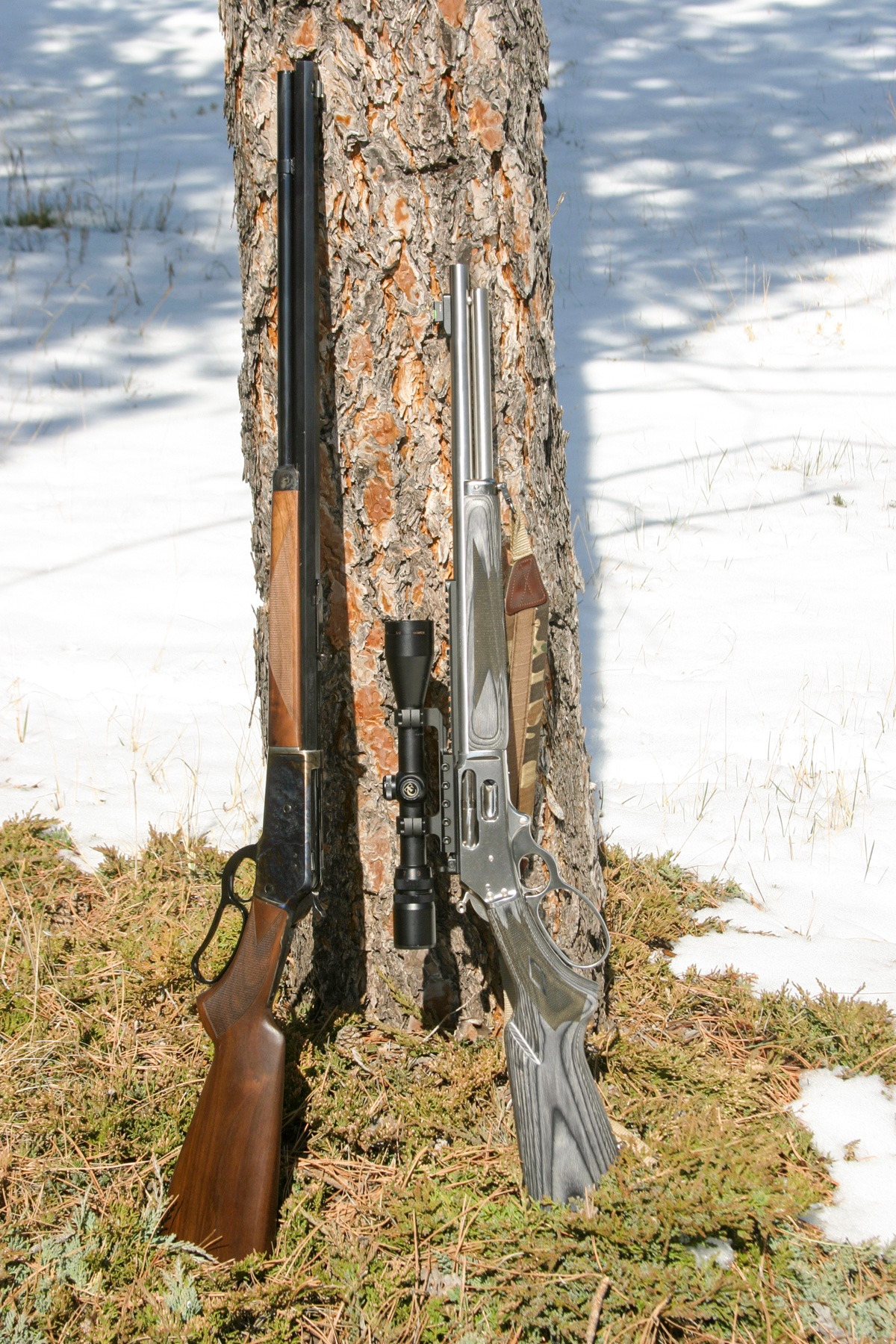
Being a long-range specialist in western South Dakota, the rifle would seem out of my league in terms of any level of range extension. The barrel on this new rifle measures a short carbine length of 19 inches, and as such pushing the 45-70 chambered bullet to any ultra-high velocity is just not a part of the program. That stated, being an owner, the 45-70 Government has been a mainstay in the Wild West for the past 20 years I have been living and writing here. I have hunted buffalo and deer with my Sharps 45-70, which mounts a set of ladder sights. And with an understanding of the rainbow trajectory involved in the 45-70, it is all just a matter of knowing where to hold when compensating for the bullet’s obvious drop.
The advantage of the cartridge is its massive, retained weight running downrange. The 45-70 can deliver lots of energy on target. Bear, elk, trophy mule deer hunters and even southern pig shooters can appreciate the knockdown power of this cartridge. It is obvious why Ruger elected to offer this new Marlin in this very old school, but effective lever-action, straight-walled cartridge.
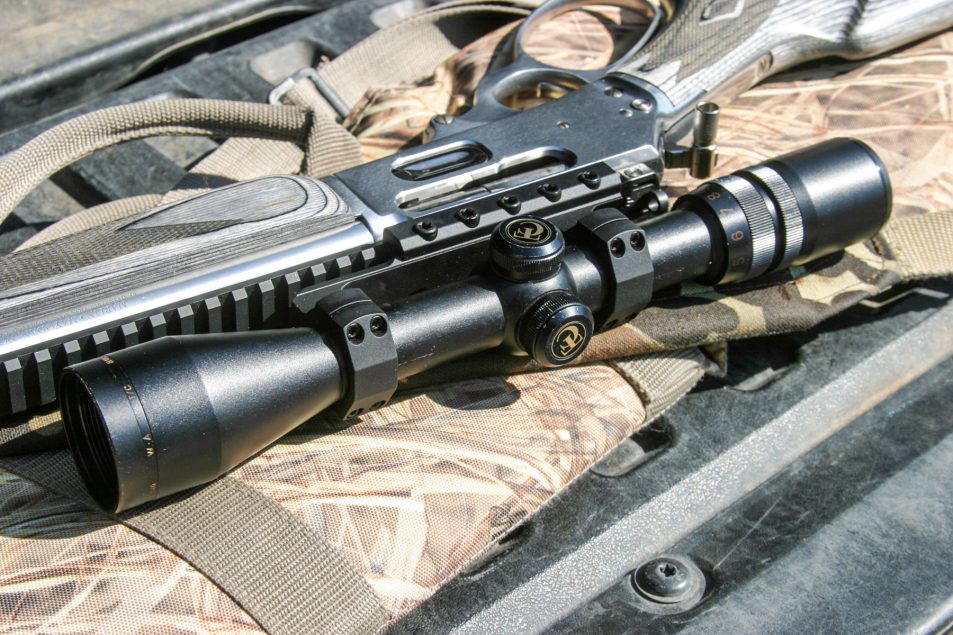
What is different about this rifle when compared to the rifles built by Marlin under their original ownership of the brand? Ruger first reviewed the old model in the 1895, after which a series of very basic design changes were made. This new rifle makes use of not only CNC production methods but additional systems that cut out very detailed parts to perfection. The result is a very smooth action and fit. This rifle retains detail fit when metal parts are installed, as well as the wood to metal fit. The stock has been reconfigured for a slimmer fore-end, and the checkering is also upgraded along with the laminated gray stock.
In terms of sights, the new rifle makes use of a ghost ring rear sight and an HV-type front ramp sight. I would much rather see an all-metal front sight with a white ramp face, but these sights seem to be the style of the day on many new firearms of late. Rifle muzzles slid into saddle scabbards, slung across the back when climbing trees or getting into high elevated artificial stands can be rough on a rifle’s muzzle. This rifle is designed for hard field applications—not resting on a target bench.
The ghost ring is also a slight problem in that it stands up very high and will not allow the use of standard, or in some cases, high scope rings. It makes use of a very long, Weaver-style rail and the use of a scope is an easy install. However, a move to an AR-style base and rings, or a very high tactical base ring setup is required. I first removed the ghost ring sight when trying to install a scope for testing, but found it to be an unsightly option, and reinstalled the rear sight. After failing with two earlier ring and base sets, due again to the inability of the mounts to clear the ghost ring sight, I selected a Leupold one-piece base and ring unit as a final option, and that seems to be a workable solution. After a mess with the base arrangement, the good folks at Scheels, the big box sporting goods store, took over and mounted, aligned and laser-zeroed the new scope mount setup for me. That was a first in my list of new experiences, as I have always just done my own work in this area.
In the scope department, I elected to use one of my old T/C 3 x 9 power units as a good option, being the scope was designed for use on the T/C Contender. This makes for a nice lightweight shorter package as applied to this carbine-length rifle. Installing a massive bell and extended tube length scope on this rifle, to my way of thinking, is way overcooked.
In terms of the lever action itself, the lever is oversized just enough to handle heavy gloves in cold weather and retains a very nice feel coupled with the rifle’s smooth action.
The rifle retains a tube magazine that carries six rounds of 45-70 Government and makes use of the right-side receiver feed tube design. The stainless steel bolt on the rifle is barber-pole cut and is very nice in terms of a polished surface treatment. In fact, everything about this rifle’s stainless steel action is first rate in attention to detail.

The action retains a push-button, cross bolt-style safety as well as a hammer half-cock position. The service manual supplied with the rifle details how the action works as well as its safety features. Let’s face it, some of the black gun boys have never fired a lever-action rifle, and in the near future could be getting into this new hunting rifle offering.
When operating the button safety, the firing pin is blocked, even though the hammer will still half cock or full cock. When the safety is pushed to the on safe red indicator position, the firing pin block is deactivated. I was trained on the old Model 94 action as offered by Winchester many years ago, but I like this button safety that adds an additional dimension of safe handling characteristics to the rifle. Also added is the use of the muzzle cap and threaded muzzle, so as to allow the use of suppressors or other muzzle devices on the rifle. This 1895 lever gun would sure seem to be a very traditional rifle, but with added space-age touches.
Are you enjoying this post?
You can be among the first to get the latest info on where to go, what to use and how to use it!
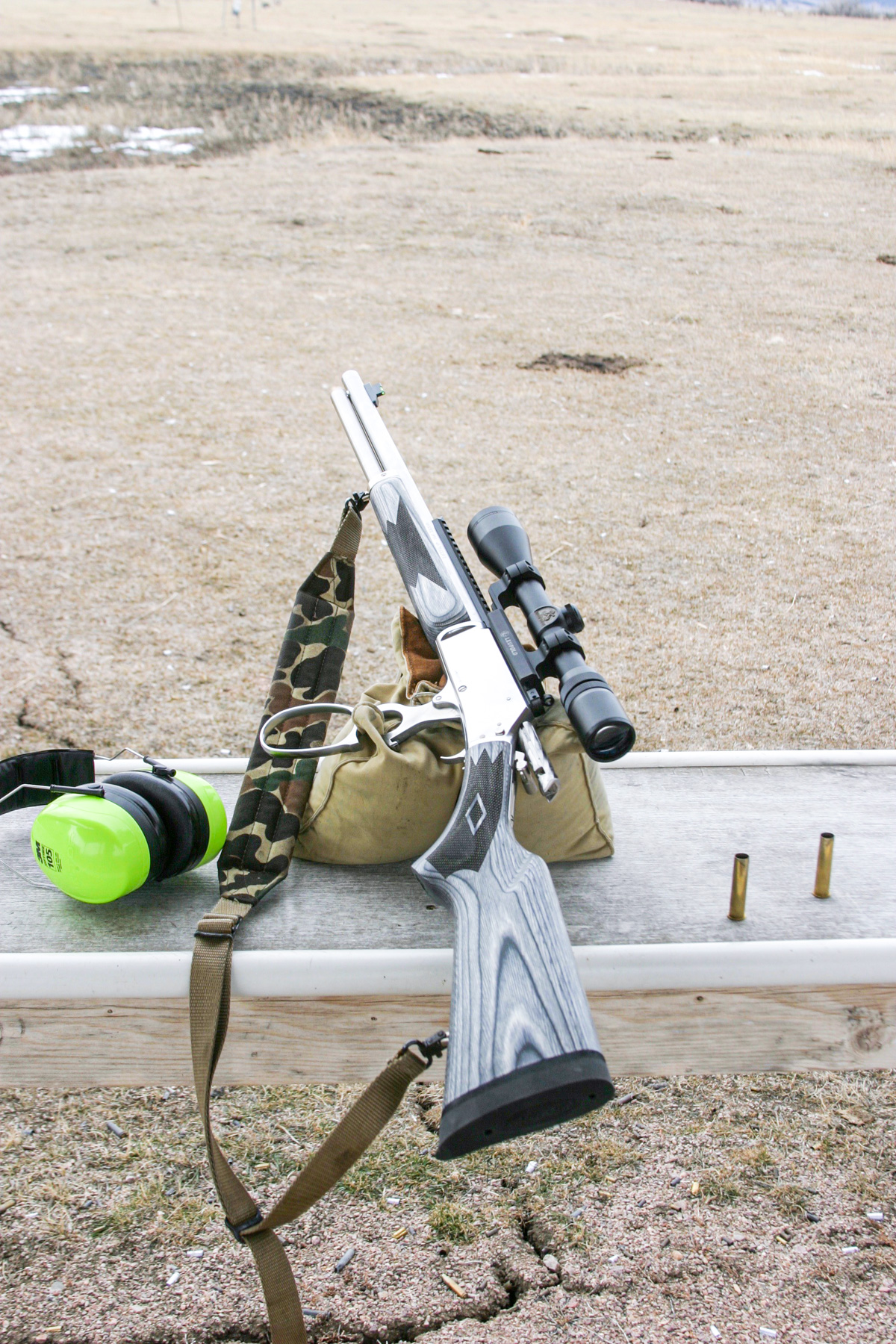
Going downrange
Going hot with the Marlin Model 1895 was, in general, a slow startup operation. Getting the test rifle from Ruger in mid-February, I was met by a South Dakota winter that was mild for these parts, but still somewhat of a challenge in staying out of very cold air and high winds that blew straight out of the northwest as it drove its icy core over the Big Horn Mountains.
The first day with live ammunition proved to be nothing but a quick function check of the total package, as the weather crashed in around me early in the day. The second day, however, was also not very nice, but workable, as I set up a portable benchrest behind a wind wall on our club range. I also used my truck to redirect the strong, 25 to 30 mph gusting winds against the line of my test bullets to the 100-yard target.
Shooting Hornady’s 325 grain LEVERevolution at a muzzle velocity of 2050 f.p.s., even with the stiff crosswind, I splashed bullets on 12- x 18-inch steel plate with ease. In terms of an accuracy group check, the test was omitted due to the obvious field conditions. Over two days, I did establish that she liked the Hornady fodder, functioned as smooth a glass regarding the rifle action, and at least until better weather could be utilized, seemed accurate as well.
The trigger on the rifle cracked off at about three pounds and was rock solid and very crisp. Control of the rifle was easy, and I could see a good group coming down the line just by the way this open hammer firing control system performed.
Balance, even when scoped, was dead-on at the mid-point, just ahead of the trigger guard. And the recoil pad, which is generous, allowed me to fire my test rounds one-handed (300 grain Federal jacketed), with the left arm resting across the rear of the bench under the rifle’s pistol grip-style stock. The rifle is much easier and forgiving to shoot than my Sharps 45-70. And according to several friends that shoot the 45-70, the recoil is much less than what is reported regarding other rifle brands chambered in this cartridge.
Control of the Marlin is so positive regarding performance that currently my friends a Backridge Ammunition in Tennessee—a company that I do a good deal of test shooting for—are having some engine-turned handmade pure copper bullets sent in 400-grain for additional bullet testing with the new Marlin. That project, set in the world of hand loading, will be left to still another day.
In terms of total weight with the scope, sling, and one-piece AR-style mounts empty, the 1895 comes in at 8 3/4 pounds, but feels a whole lot less when brought up to the firing position.
Shooting on the second week, as nicer weather came in, produced good accurate groups just inside 100 yards. Open-range winds were still rough, and I elected to shoot on a heavily wooded, shorter shotgun patterning range that had been extended just a bit. When shooting 300-grain bullets, the Federal Fusion brand, I was able to “walk” my bullet within 1/2-inch per adjusted shots anyplace on the target that I moved my primary impact point. I wanted to zero for 200 yards, and as such, make some correction in terms of what had been achieved at Scheels, when laser zeroing had been applied.
Not being a long-range cartridge, at least as applied to this carbine setup, I was interested in keeping my shooting ranges on game inside 300 yards. When shooting for zero, my target was impacting bullets 2 1/2 inches high, which put my impact point on the 200-yard target at a bit low at 3.5 inches. With the move to 300 yards, being my max range, I was required to hold over a full 28 inches using Hornady LEVERevolution bullet drop data. With an 18- to 20-inch-high hold, a bullet would find lungs and heart using a side-body shot. And a straight head-on shot at a mule deer using the same hold would drop in via a head-on chest shot, while holding on the animal’s noise. Hunting buffalo and trophy timber whitetail for years by way of my Sharps, I had a good feel for the performance base of this cartridge and paired rifle.
By way of hog and buffalo targets at 200 yards, the results were effective, to say the least. With a sight picture hold at the upper edge of the picture target’s shoulder, the Federal Fusion 300 grain bullets being tested were dropping 11 inches low, but would, as previously noted, take out lungs and heart. Pushing the shot to 300 yards, again using Hornady’s published drop table, was difficult, however; I was able to make general hits on steel, but accuracy group shooting with again sustained winter’s high winds made that event completely out of the question.
When shooting for basic groups at 100 yards, the Hornady 350-grain bullets shot a best three-round print, putting two bullets in the same hole, and the third exactly .966 alongside the previous pair. What was also special about this group was that the high winds had pushed the bullet group a full 3 1/2 inches to the left off center. The wind was a full value right to left in this case, and the performance profile of the 45-70, save for its rainbow trajectory, is very predictable in the area of wind drift. About all I can say is that buffalo hunters of old had to know their stuff when pushing the range limits of the 45-70 Government round.
In real life, when hunting whitetails in timber here in the Black Hills, and even buffalo on the Triple U covering some 200-yard shooting, the actual control of the cartridge regarding longer-range shots is more difficult than you can imagine at times. In my opinion, based on the history I have with the Sharps 45-70, and now the new Marlin 1895, which is a rifle not going anyplace but into my truck, hunters can expect great performance to 200 yards. But things will get a bit dicey beyond that indicated range limit, lacking extensive practice.
Average groups at 100 yards measure about 1 3/4 inches, and at 200 yards (again, under real-world hunter encountered weather), opened them up to 3 3/4 inches. With dead air, warm weather and a benchrest setup using sandbags, the longer-range groups could without question be improved upon. However, this being a hunting rifle and not a benchrest tool, I was very pleased with the performance results generated by the new Ruger-engineered Marlin 1885.
Thanks to the following for product support: Ruger / Marlin firearms, Hornady Ammunition, Federal Cartridge, Scheels Sporting Goods, Backridge Ammunition, A/T Targets, and Uberti Firearms
Writing on outdoor subjects for over 40 years, L.P. Brezny has written four books on shotgun and rifle (ballistics and performance). He’s an expert at smoothbore, and high-power, ultra-long-range shooting. He’s a specialist, producing reviews covering general products used in the outdoors industry.
MWO
SHARE THIS POST
Did you enjoy this post?
You can be among the first to get the latest info on where to go, what to use and how to use it!
L.P. Brezny
Writing on outdoor subjects for over 40 years, L.P. Brezny has written four books on shotgun and rifle (ballistics and performance). He’s an expert at smoothbore, and high-power, ultra-long-range shooting. He’s a specialist, producing reviews covering general products used in the outdoors industry.
